It has been some time since you have received a Newsletter, simple reason—have struggled to find any news that might be of interest. However, the old adage “No News, is Good News” maybe does hold true as a few weeks ago:
Our proposal to develop and build a second Hydro based on the Weir in Congleton Park was finally granted Planning Approval – more on this later!
This summer has been both Good and Not So Good. Good in rucks of fine weather and sunshine, so great for Solar performance, but Not So Good for hydro as hardly any decent rainfall for the past few months. The sun brought smiling faces to the pupils of Havannah Primary School – one of our recent Solar Installations, which was officially “switched on” by Congleton’s Member of Parliament, Sarah Russell. Sarah is a Champion of Green/Renewable Energy and has introduced several schools to the opportunities that Solar might offer them. Sarah is also keenly interested in our future hydro projects and likes to be kept informed of progress in re-developing these historic Weirs to once again be usable sources of Renewable Energy.
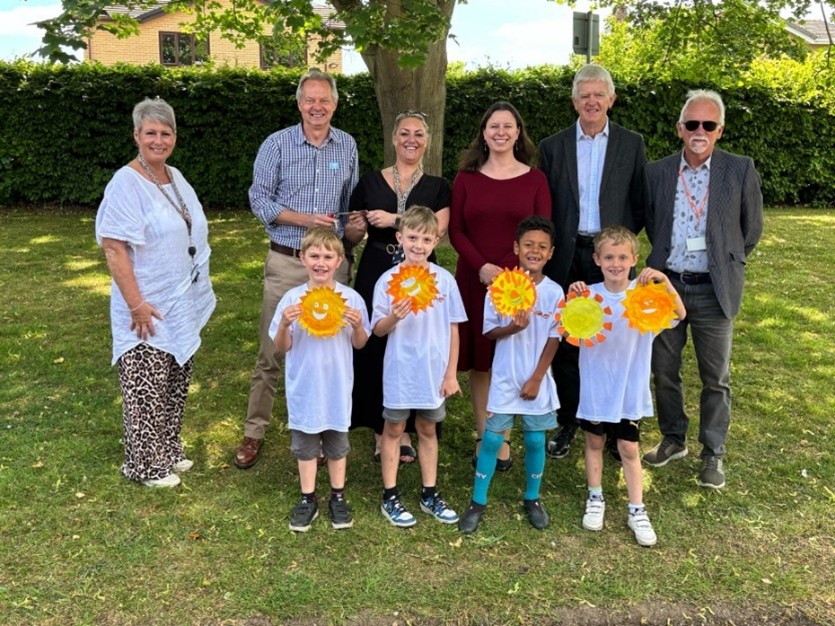
The Havannah Primary School installation has generated over 7MWh to date:
- Over 35% reduction in electricity consumption – 46% in August alone!!
- Over £300 saved for the school in purchased electricity to date.
- Over 1.4 tonnes of carbon saved, equivalent to 84 new trees being planted.
Despite the absence of “Generating Rain”, thanks to our Variable Speed Drive Control System, Archie has not gone to sleep and has continued to produce some power and our cumulative power generated to date, although behind spot target, remains healthy.



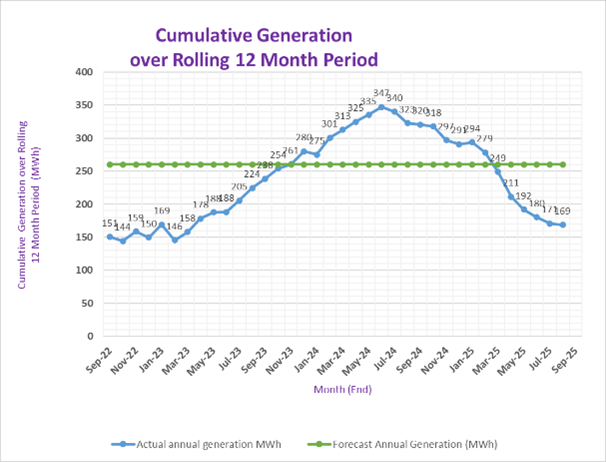
Key performance data is shown in the above graphs. The first chart indicates that currently, we are about 150MW (15%) short of the “lifetime to date” generation. However, the forecasted Autumn and Winter storms will bring us back to full generation and start the catch-up process. Financially, we are basically in line with the business plan, although down on generation, we have benefited from the higher energy rates brought about by world events.
You will (hopefully) recall from previous Newsletters that with funding via a CEF (Community Energy fund) grant, we were undertaking a feasibility study to identify cost-effective hydro solutions based on three Weirs on the River Dane—Congleton Park, Washford Mill and Eaton Bank. Work was split into three packages: Site Surveys, Technology Reviews and Design and Costings.
Site surveys are substantially complete.
The following technologies have been evaluated.
- Pit Francis
- Kaplan Propeller
- Siphonic Fish Friendly Kaplan
- Archimedean Screw
- Vortex
Washford has then been used for a site-specific evaluation based on Costs (civils, electrical and mechanical and the turbines themselves). Dominating the selection criteria for the Turbine are the Environment Agency requirements, eg Fish fish-friendly and those of controllability, reliability, debris Management etc. None of the turbines tick all the boxes but the Archimedean Screw comes out as the preferred solution for Washford and The Park. (Eaton Bank being a much small Weir needs separate investigations to determine its commercial potential).
Work is currently progressing on the third package, i.e. the design and costings. Base design is more or less complete, and most activity is now going into realising a civils package that will make the scheme financially feasible. Civil costs for all turbine technologies are the highest cost component of any hydro project. A key area being investigated is the possible use of pre-cast reinforced concrete channels, etc, instead of the “Piling and Trenching” techniques used at Havannah. Initial results indicate good possibilities. Several civil contractors have been asked to consider this approach to hopefully realise a scheme that will underpin a viable overall business plan. Interestingly, this possible approach has been the subject of a substantive research programme funded by the US Department of Energy. For those of you who enjoy the technical minutiae, this can be accessed via Optimization of Archimedes Screw for Use in Hydroelectric Projects (Technical Report) | OSTI.GOV. We aim to finalise the output of the complete study, based on Washford, by the end of October. For Washford, the next stages (assuming the business plan is realistic) will be to apply for Planning and EA approvals.
Back in the late 1700s, when these Weirs were originally constructed, there were no such things as Planning Permissions and Environment Agency Approvals. No power tools, steam-assisted machinery had not yet materialised anywhere, let alone in Congleton. Grimshaw of Boulton & Watt devised the first steam-powered excavator in 1796, William Brunton patented another steam-powered excavator in 1836, and the Steam Shovel was invented by William Otis in 1839. Costs were in the order of a hundred pounds or so, although I guess in those days it would be “Guineas”!! (Some of you will know what Guineas are, for those that don’t, will leave it to you to further educate yourselves!!—try Wikipedia for a start Guinea (coin) – Wikipedia.)
With just hammers, chisels and a good eye, Weirs were produced with perfect flat tops, solid construction that has stood the test of time and all that turbulent rivers can throw at them. Today, with the assistance of computer-assisted excavators and diggers, CAD and all sorts of computerised design tools, Planning and EA requirements, etc, costs are in the upper hundreds of thousands of pounds. Guess that’s what you would call inflation, but not sure what the metric would be for technology-assisted progress????
Leaving Hydro for the moment, let’s take a look at Solar.
Our first project, Astbury Golf Club, has been up and running for one year and has been a great success. The solar panels have generated 38 megawatt-hours (MWh) of green energy over the year, which is in-line with the designed performance. An average household consumes 2.7 MWh per year (Ofgem) so the Astbury system could have powered 14 homes for the year. Over 85% of the green energy generated was consumed by the Club and the remainder was exported back to the grid.
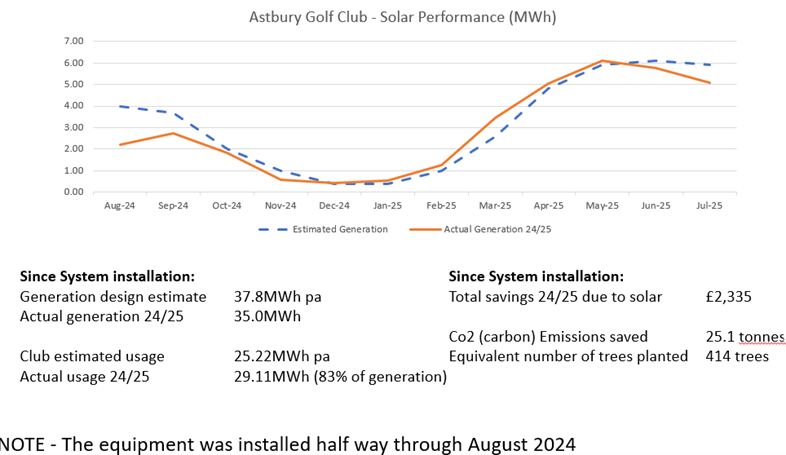
Our latest project, The Daneside Theatre in Congleton, www.danesidetheatre.co.uk was completed in June and is also performing to expectations.
Because of the Theatre’s electricity usage profile, which is mainly in the evening, a 24-kWh battery is installed. The solar panels charge the battery during the day, and then the Theatre uses the power from the battery during the evening. The next time you visit Daneside Theatre, congratulate yourself that your share contribution is helping to “Illuminate” this fantastic Theatre Company.
Despite these successful projects, we are still finding it a challenge to recruit new customers. Commercial organisations find it difficult to commit to a 25-year contract, which we need to recover the cost of the solar equipment and installation. We have a list of prospective customers but practically realising them is taking a lot longer than expected. These delays reduce our revenue stream and delay the time when we can make the interest and capital payments to shareholders. If you have any contacts at a school or other community organisation that might benefit from our Solar scheme, we would be very grateful if you would ask them to drop us a note at shares@congletonsolar.co.uk.
As Headlined above, we have been granted Planning Approval for a Hydro Generation Scheme using the potential energy of the Weir in Congleton Park.
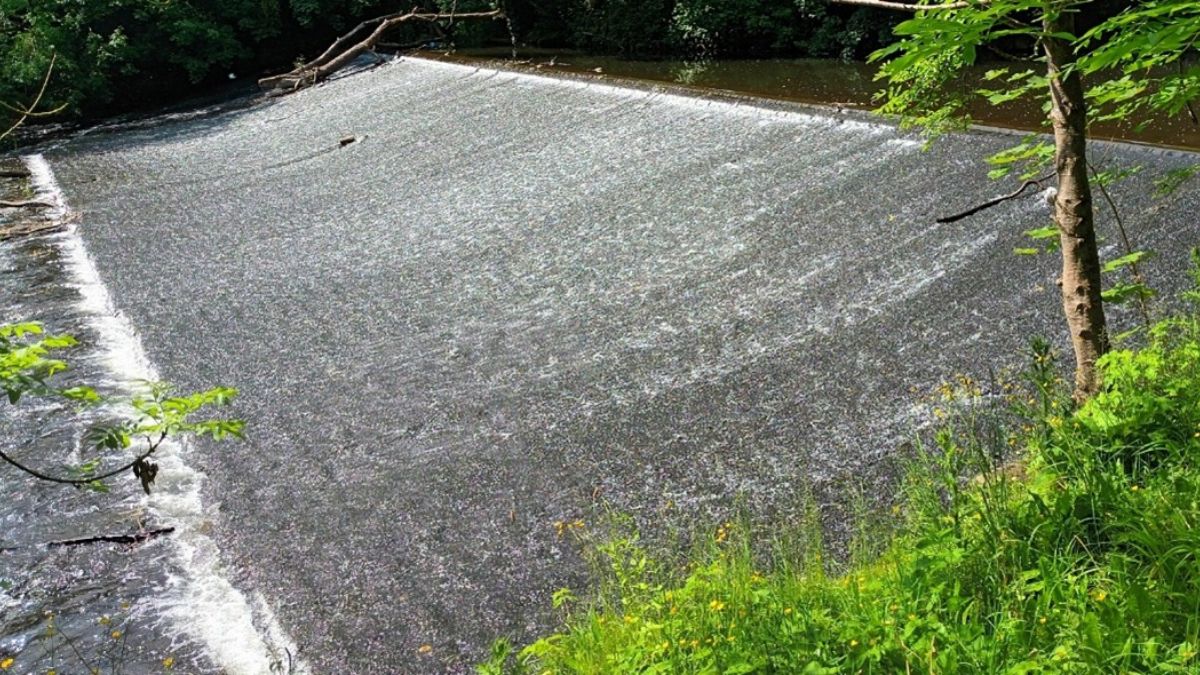
The Weir, just on the edge of Congleton’s Grade II (Historic England’s Register) Park (Congleton Park – Wikipedia), was originally built sometime before the 16th century, to provide the base to power the wheels of Congleton’s Corn Mill. Initially constructed of wood, it was rebuilt many times over the years, with the present stone structure built around 1814. Slightly smaller than the Havannah Weir, it realises a usable head of 2.5m, which will enable an output of approx. 50 kW and an annual output of approx. 200,000 kWh.
The Planning approval is just the start of the journey to realise a viable hydroelectric generation Scheme. There are a number of conditions to satisfy, many of which will require additional submittals, e.g. Landscaping Plan, Flood Risk Assessment, Bio Security and Biodiversity Net Gain Plans, Control Building Facing Materials, etc. We will also require an Abstraction License and Flood Risk Permits.
Other Pre-Construction Challenges include:
· Land Ownership
· Land Use Covenant (usage covenants date from Victorian days!!)
· Gas and Sewer main diversions
and of course, the realisation of the Business case viability. A lot of the feasibility outputs (as described above for Washford) will also apply to the park and inform the key elements of the business plan. Since receiving the Planning Approval, we have held an excellent and most productive meeting with the relevant Cheshire East Stakeholders to discuss the various conditions, and we have confidence that we will be able to jointly work together to find solutions to issues that may arise. Well Done and Thankyou to Cheshire East Council. The Export Power Cable, for a number of reasons, was not part of the Planning Approval and will require a separate application. We have just held a Cable Route Walkdown with the key officers from Cheshire East and have agreed on the basic route and laying methodologies.
With so many planning and additional conditions to work on, we will now establish a step-wise project plan to take us forward. Updates in the next newsletter.
As mentioned in a previous newsletter, our rewilding efforts have proved to be overwhelmingly successful. The majority of trees and plants have thrived, and the Alders in particular have prolifically self-seeded. Our great and enthusiastic group of Volunteers now concentrate on the Woodland Management. Over winter 2023-24, and again in 2024-25, nearly 4,000 surplus Alder seedlings were dug out, bagged up and distributed to other local tree-planting groups for replanting. (Congleton Hydro is rapidly becoming a major source of whips and saps for the wider area.)
But the seedlings have now become too large to easily dig up, and although alders are an intrinsic part of the river valley woodland, some will still need to be thinned or removed in future. Alder makes good firewood, for those with wood-burning stoves, but cut trees and branches could also be stacked on site to provide a good habitat for amphibians, small mammals, fungi, invertebrates and other forms of life.
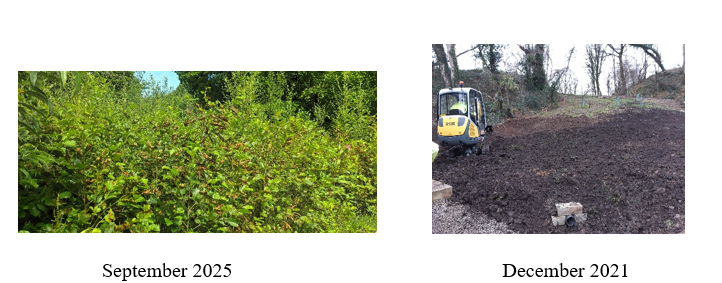
The new woodland is growing fast, and together with the giant horsetails and willowherbs is becoming a temperate jungle which, despite alder removal, is becoming increasingly difficult to get through. Over the coming autumn and winter months, the South Manchester and the Congleton and District Conservation Volunteers will be helping to create paths which will help with the eradication of Himalayan Balsam, and with the removal of diseased or invasive trees to allow regeneration with native species suited to the wet woodland conditions.
Efforts by volunteers to get rid of Himalayan Balsam have been partially effective, with the river corridor cleared this year, as well as accessible slopes above the boardwalk and in the new woodland areas. The plant is annual, and seeds are only viable for 2 years, so a target of complete clearance by 2028 or thereabouts is doable if enough people can help, with May to early July being the best time before seeds are set. It’s a challenge!
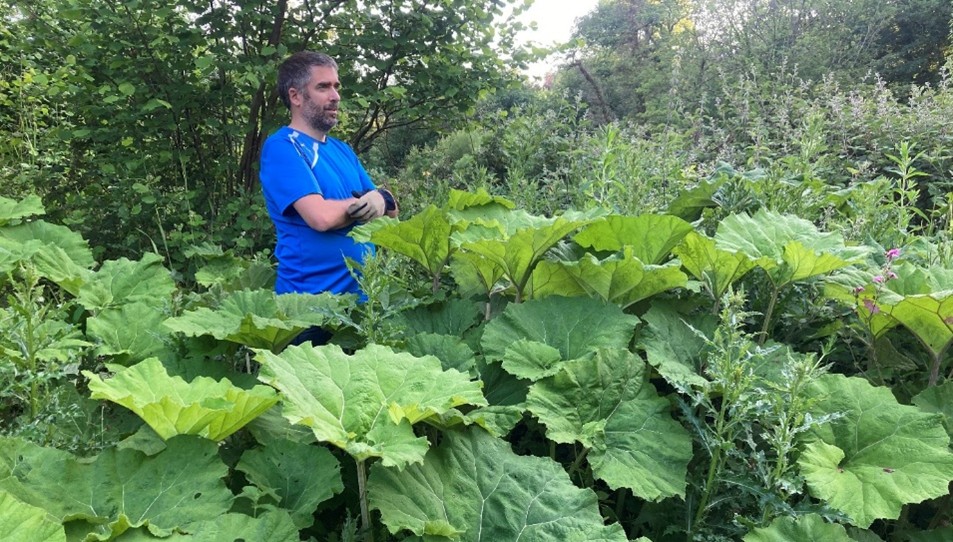

No Alder or Balsam in sight, just giant Butterbur leaves (June 2025) and Marestails/Horsetails
Regular newsletter readers may recall that for some time, we have been looking to derive a safe and economic process to renew the oil in Archie’s Bottom Bearing. Major difficulty is that accumulations of gravel (The Dane is a gravel-carrying river) prevent the seating of stop logs to block the river flow. As such, it has not been possible to reduce the “outfall water” levels to a safe working limit (and most certainly outside the scope of ourselves. Finally, a specialised outside contractor managed to clear some gravel, installed stop logs that partially blocked the river backflow and then used powerful (and heavy) suction pumps to create a “dryish “working environment. We have taken this opportunity to play safe, not sorry, and replace the complete bearing housing assembly.
The bearing should only really need replacing at a minimum of ten years of usage, but having gone to a lot of trouble to gain safe access, we have replaced it. A specialist engineering contractor will now take to their premises, strip down, produce a condition report, and then insert a new bearing into the housing. This will now give us a spare bearing assembly. The inspection report will better inform us of the likely lifetime of the bearing. In the unlikely event of a major unplanned bearing failure, having a spare assembly on site will enable us to achieve a system downtime of about two days to replace it. As opposed to a lead time of approximately 14 weeks to procure from the manufacturer.
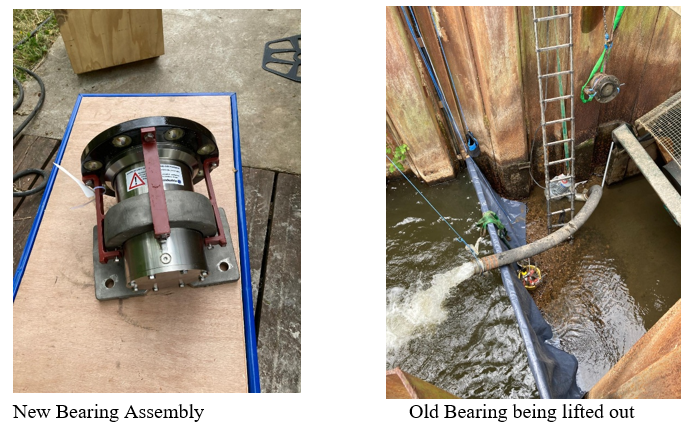
A key objective of Congleton Hydro (and Solar) is to generate surplus funds to enable the funding of suitable Projects in the Community, especially those projects that look to improve the environment and its sustainability (if they have a STEM –Science Technology Engineering Maths element, so much the better). Last year, several local schools benefited from awards of up to £1000, which enabled projects that varied from auditing wildlife in their vicinity to establishing a community garden.
An interesting application was received (and funding was then agreed) from The Big Clothes Movement, led by two co-directors and supported by 20 active volunteers, which engages over 2,000 service users through its preloved clothes initiative. With the support of a £400 grant from Congleton Hydro & Solar, the group hosted two children’s clothes events at Congleton Town Hall, hiring both the venue and a van to manage donations and stock. At these events, donated clothes, shoes, and accessories are quality-checked, organised, and offered to families for a nominal charge of £2 per large shopping bag, helping cover running costs while promoting sustainability. The project aims to rehome as many items as possible, reducing landfill waste and ensuring families can access affordable clothing, while also strengthening Congleton’s community spirit and commitment to reuse. May long they continue!
This year, the money (agreed by members at the AGM) has been increased to £10,000. Together with donations from some shareholders, this gives a fund this year of approx. £11,000. The fund opened for applications on Sept 1st and closes on October 1st. Fingers crossed, we will have plenty of worthwhile applications.
Generating applications has not been an easy task—one would have thought that giving away money would be the easiest part of the Hydro operations! Each year we’ve tried to simplify the application process and generate rucks of publicity about the scheme.
This year we’ve organised a poster campaign and as many different media as possible, e.g. Facebook, website, local newspapers, etc. To further publicise the scheme, Members of the Community Donations Committee have contacted/visited the majority of schools and youth/community groups in the area.

Underpinning everything we do is the team of Volunteers. Re-wilding/Conservation, de-Trashing (although they have had an easy time during the summer months!) and the regular maintenance tasks, e.g. path maintaining, bearing greasing, oil checks etc. This year, the boardwalk and the powerhouse exterior needed further coats of wood treatment. A team from Siemens kindly spent a couple of days on site with pots and brushes, applying many gallons of Ronseal. The result is boardwalk and powerhouse ready to survive more years of winter weather and looking spick and span as well. Leading the team of Volunteers was the Siemens Chief Exec Christian Grosch, and befitting being the “top man” also (after appropriate ladder safety training) treated the top heights!
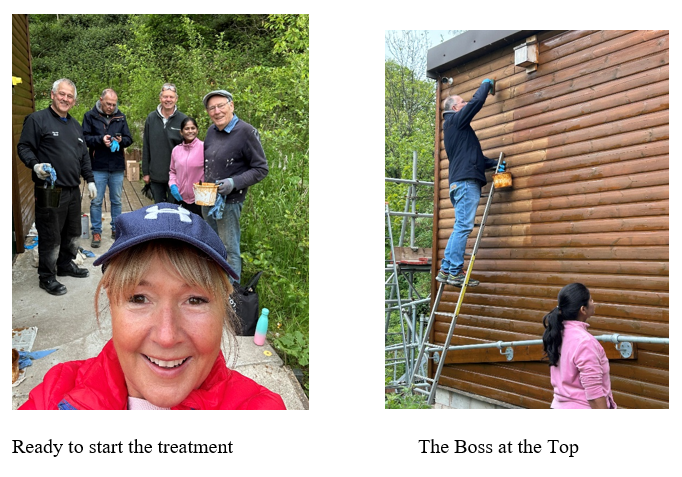

One of our “de-trashing” Volunteers, Heather Watson, has taken advantage of the lack of trash and put effort and energy into helping provide the content for a booklet describing a series of walks in and around Congleton. The eight walks range from 1.5 to nine miles and are all circular, allowing leisure seekers to join at any point. One of the routes passes the entrance to Congleton Hydr, and another skirts past the Park Weir. Well done, Heather, for walking and describing all the walks.
Whether you live in Congleton or are thinking of visiting our beautiful town, this walking guide is available free of charge from the Information Office located in the Town Hall
During the first week of September, we had a visit from Environment Agency Inspectors. Purpose of their visit was to check we were adhering to the terms of our Abstraction licence e e.g. ensuring we stick to the limits for maintaining the water level over the Weir (for both environmental and aesthetic reasons), the “rubber bumpers” on Archie were still all in place and in good condition (these are required to ensure that any fish do not get bruised whilst passing through Archie). The Inspectors were happy that we were ticking all the boxes on their checklists and described Congleton Hydro as a “cracking scheme”— which we totally agree with!
Finally, please help us by praying for the perfect weather:
Glorious Sun during the day and Tempestuous Rains during the night!!
We hope you have found this newsletter informative and interesting. As usual, we value your feedback via admin@congletonhydro.co.uk


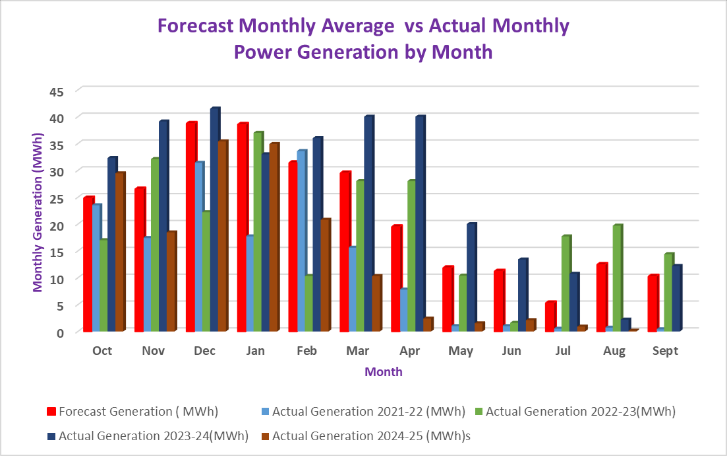
Recent Comments